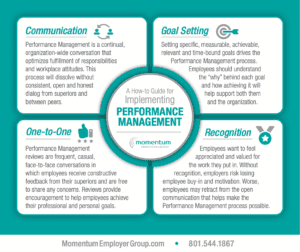Performance management is an iterative, continual process that optimizes fulfillment of responsibilities and workplace attitudes. But more than that, it effectively measures employee progress—both professional and personal—and verifies that development is moving in a strategic direction for the company. The personal development component of performance management considers what behaviors, skills or knowledge individuals need to develop in order to succeed in an organization.
So, what does performance management look like? It’s an ongoing and open conversation between employee and employer. The operationalization is flexible and adaptable to each organization and workforce. It’s about setting SMART goals. And it identifies what’s expected of both employee and employer.
Rather than a list made up of rigid “steps,” this workplace practice is composed of some basic guiding elements.

Goal Setting
Keep goals SMART, meaning they’re Specific, Measurable, Achievable, Realistic and Time-bound. Employees need to understand the “why” behind the goals. How will achieving the goals support the organization’s strategic development? How will each goal help the employee grow in their role? Ensuring employees understand the underlying context of each goal will help them commit to achieving the desired outcome.
Ultimately, a successful performance management system should develop a coaching culture. And following the GROW model of coaching and mentoring can help managers lead their employees throughout the performance management process:
-
Goal—What do you want? Define what outcome to achieve, and why.
-
Reality—Where are you now? Understand the who, what, when, where and why of the current reality to help illuminate the way forward to achieve the goal.
-
Options—What could you do? Brainstorm as many good options as possible to reach the goal.
-
Will—What will you do? Have a plan. The last step in the GROW model asks, “what now,” and places something concrete in front of the employee to achieve. This keeps employees motivated and can help remove immediate, obvious obstacles.
Lastly, it’s important to understand that goal setting should be a collaborative process. A coaching culture means managers aren’t telling employees what to do but allowing them to discover for themselves—with guidance. The next element of performance management needs to be engrained in the day-to-day operations.
Communication
Simply put, performance management will dissolve without consistent communication from managers and between peers. Building relationships is critical to creating a coaching culture—and relationships can’t be built without open communication. It’s helpful to think of performance management as a continual, organization-wide conversation. Regular feedback and honest discussion are essential for employee development, even if it’s uncomfortable or awkward. It will help to keep people on track to meet the goals they set.
One of the most crucial pieces of the communication element is documentation. While performance management itself is less structured than some traditional workforce management systems, documentation is elemental to ensure managers and employees are accountable for the goals they set. But this documentation doesn’t need to be complicated.

One effective way we have seen companies handle documentation is by simply providing their staff with a personal notebook. Here, employees can keep notes on anything—from their daily struggles to recent accomplishments. Regular reviews provide the much-needed opportunity for employees to share their notes and thoughts with managers.
One-to-One
One-to-ones aren’t the typical, dreaded yearly or quarterly performance reviews in the manager’s office. Rather, these should be casual, face-to-face conversations in which employees receive the needed feedback and, perhaps, fresh perspective to continue progressing. The more frequent managers can meet with their employees, and the more precise the feedback, the better. Again, employees want open and clear communication.
And these don’t need to be a substantial time investment, just long enough to make sure employees are given the necessary feedback to move toward their goals and have enough opportunity to share. Keep records of the important parts of the conversation: goals, obstacles, discoveries and successes. Doing so will provide a barometer for future one-to-ones and allow the employee and manager to track progress.
And while documentation is important throughout the one-to-one, it becomes essential if corrective action is required. If that’s the case, make sure the corrective steps are specific and understood by the employee and closely document your conversation for future reference.
Recognition
It should go without saying, but employees want to feel appreciated and valued for the work they put in every day. Indeed, recognizing employees’ contributions is an important element of performance management. Without it, managers risk losing employee buy-in and motivation. Worse, employees may retract from the open and continued communication that makes not only performance management possible but also prompts effective role fulfillment.

GROW Into Performance Management
Setting goals, communicating openly and continually, holding regular reviews and valuing employees are the elements of a successful performance management system. And the GROW model of coaching and mentoring can help guide managers’ decision-making throughout the process. But these aren’t the “steps” of performance management; rather the essential elements. This means the process doesn’t proceed from one to the other in any chronological order. The elements take place side by side, they intertwine and complement each other.
Momentum Employer Group enhances our clients’ processes through innovative and complete human resource management. Utilizing the latest trends in human resource solutions, we help organizations, both large and small, build engaged, productive workforces. Our qualified team has helped implement performance management systems that create positive and engaged workplace attitudes that are crucial to organizational success. Contact us today for all your human resource needs at 801-544-1867.


